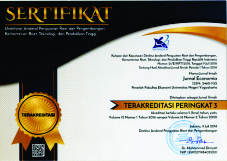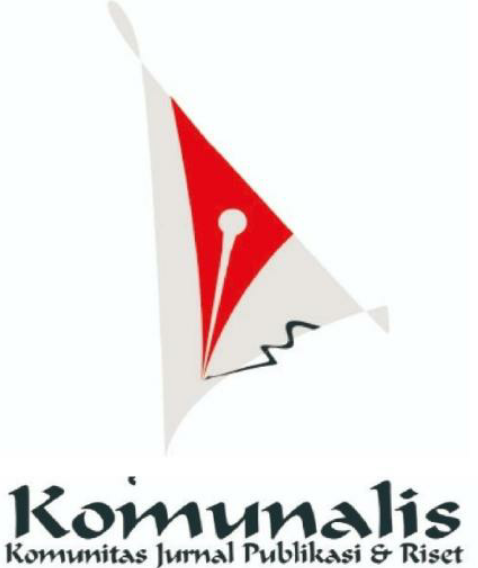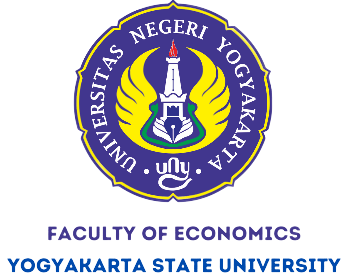Do Internal Capabilities Affect Competitive Advantage? The Case of a Regional Owned Company
Downloads
Abstract
This research aims to get an overview of the factors affecting organizational competitive advantage and to obtain insights into the most influential factors concerning organizational competitive advantage. This research used the Integrated Talent Management Scale, Utrecht Work Engagement Scale-9, Employee Satisfaction Scale, Employee Performance Scale, and Competitive Advantage Scale. This research followed a quantitative approach. Then the data used in this research was primary data. The researchers gathered data without intervention. This research followed the variance-based structural equation modeling with partial least squares (SEM-PLS) and used SMART PLS as a tool. This research collected 108 types of data by distributing surveys and using the Likert scale. The sampling method in this research was done through non-random sampling and purposive sampling. The questionnaires were distributed to a Jakarta regional owned enterprise. This research found that employee engagement has no impact on employee satisfaction or employee performance in a regional owned company, and employee satisfaction has no impact on competitive advantage in a regional owned company.
Keywords:organization, competitiveness, advantage, factors
Downloads
Alagarsamy, S., Mehrolia, S., & Aranha, R. H. (2020). The mediating effect of employee engagement: how employee psychological empowerment impacts the employee satisfaction? A study of Maldivian Tourism Sector. Global Business Review, 0972150920915315.
Al-Hussaini, S. H., Turi, J. A., Altamimi, A. N. A., Khan, M. A., & Ahmad, M. (2019). Impact of talent management strategies on employee performance behaviour with the mediating role of talent management outputs. Archives of Business Research, 7(3).
AltindaÄŸ, E., í‡irak, N. Y., & Acar, A. Z. (2018). Effects of talent management components on the employee satisfaction. Journal of Human Resources Management Research, 2018, 1-20.
Anitha, J. (2014). Determinants of employee engagement and their impact on employee performance. International journal of productivity and performance management.
Bailey, C., Madden, A., Alfes, K., & Fletcher, L. (2017). The meaning, antecedents and outcomes of employee engagement: A narrative synthesis. International Journal of Management Reviews, 19(1), 31–53.
Elrehail, H., Harazneh, I., Abuhjeeleh, M., Alzghoul, A., Alnajdawi, S., & Ibrahim, H. M. H. (2019). Employee satisfaction, human resource management practices and competitive advantage: The case of Northern Cyprus. European Journal of Management and Business Economics. https://doi.org/10.1108/EJMBE-01-2019-0001
Fidyah, D. N., & Setiawati, T. (2020). Influence of organizational culture and employee engagement on employee performance: job satisfaction as intervening variable. Review of Integrative Business and Economics Research, 9(4), 64-81.
Gautam, D., & Bhandari Ghimire, S. (2017). Psychological empowerment of employees for competitive advantages. International Journal Of Law And Management, 59(4), 466-488. doi: 10.1108/ijlma-03-2016-0035
Hair, J. F., Ringle, C. M., & Sarstedt, M. (2011). PLS-SEM: Indeed a silver bullet. Journal of Marketing theory and Practice, 19(2), 139-152.
Hair J.F., Sarstedt, M., Hopkins, L., & G. Kuppelwieser, V. (2013). Partial least squares structural equation modeling (PLS-SEM). European Business Review, 26(2), 106-121. doi: 10.1108/ebr-10-2013-0128
Jatmiko, B., Udin, U., Raharti, R., Laras, T., & Ardhi, K. F. (2021). Strategies for MSMEs to Achieve Sustainable Competitive Advantage: The SWOT Analysis Method. The Journal of Asian Finance, Economics and Business, 8(3), 505-515.
Jayaraman, S., Talib, P., & Khan, A. (2018). Integrated Talent Management Scale: Construction and Initial Validation. SAGE Open, 8(3), 215824401878096. doi: 10.1177/2158244018780965
Kertiriasih, N. N. R., Sujana, I. W., & Suardika, I. N. (2018). The effect of leadership style to job satisfaction, employee engagement and employee performance (study at PT. Interbat, Bali, Nusra, and Ambon). International Journal of Contemporary Research and Review, 9(03), 20592-20600.
Krejcie, R. V., & Morgan, D. W. (1970). Determining sample size for research activities. Educational and psychological measurement, 30(3), 607-610.
Kristiana, I. F., & Purwono, U. (2019). Analisis Rasch Dalam Utrecht Work Engagement Scale-9 (UWES 9) Versi Bahasa Indonesia. Jurnal Psikologi Universitas Diponegoro, 17(2), 204-217.
Kumar, N. S., & Kapoor, S. (2021). "Is Employee Engagement The Same As Employee Satisfaction? A Complete Theoretical Perspective. Turkish Journal of Physiotherapy and Rehabilitation, 32, 3.
Laras, T., Kresnanto, N. C., Raharti, R., Nurwiyanta, N., & Wibowo, A. G. (2019). The effect of knowledge management and talent management on employee performance and the impact on competitive advantage (Survey at private colleges in Kulonprogo district, Yogyakarta). MEC-J (Management and Economics Journal), 3(1), 41-54.
Lee, Y. C., Ho, L. H., & Liang, C. H. (2006). Using Kano's model to evaluate employee satisfaction–as applied for Taiwanese high-tech industry. The Journal of Global Business Management, 2(2), 160-7.
Porter, M. E. (2001). The value chain and competitive advantage. Understanding business processes, 2, 50-66.
Rabbi, F., Ahad, N., Kousar, T., & Ali, T. (2015). Talent management as a source of competitive advantage. Journal of Asian business strategy, 5(9), 208.
Radhika, T., & Dayini, V. (2017). Employee Satisfaction–A pavement for Sustainable Competitive Advantage.
Reidhead, C. (2020). Impact of organizational culture on employee satisfaction: A case of Hilton hotel, United Kingdom. Journal of Economics and Business, 3(1).
Sendawula, K., Nakyejwe Kimuli, S., Bananuka, J., & Najjemba Muganga, G. (2018). Training, employee engagement and employee performance: Evidence from Uganda's health sector. Cogent Business & Management, 5(1), 1470891.
Setyaningsih, W. (2019). Enam Karyawan Terbaik PD PAL Jaya Dapat Penghargaan - Beritajakarta.id. Retrieved 7 January 2022, from https://www.beritajakarta.id/read/72586/enam-karyawan-terbaik-pd-pal-jaya-dapat-penghargaan#.Ydg11f5Bzcc.
Sopiah, S., Kurniawan, D. T., Nora, E., & Narmaditya, B. S. (2020). Does talent management affect employee performance?: The moderating role of work engagement. The Journal of Asian Finance, Economics, and Business, 7(7), 335-341.
Uysal, G. (2013), "SHRM: progress and return", China USA Business Review, Vol. 12 No. 11, pp. 1096-1104, available at: http://ssrn.com/abstract=2564017 (accessed June 7, 2017).
Wold, H. (1980). Model construction and evaluation when theoretical knowledge is scarce: Theory and application of partial least squares. In Evaluation of econometric models (pp. 47-74). Academic Press.















